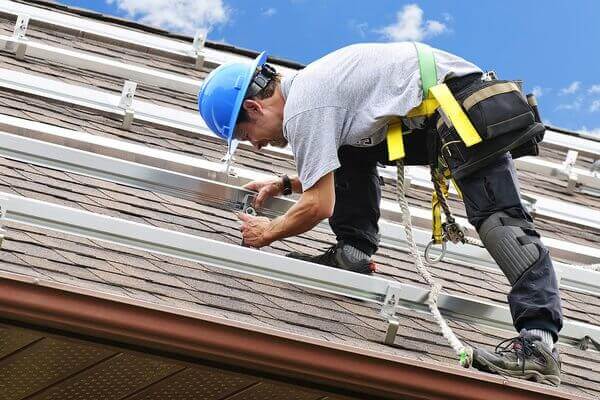Having a new roof installed can be a very expensive undertaking, when you do however go ahead with, you are entitled to know you are getting a proper and mistake free roof installation. Make sure to avoid expensive mistakes and roof failure by knowing what signs to look out for during the installation.
Top Choice Roofers has put together a list that of things that can commonly go wrong during the installation process of a roof.
Not Matching Tiles
One of the most common mistakes is when a roofer used various dealers to source the roofing tiles for your roof. Always insist they get the tiles (especially slate tiles) from the same manufacturer.
Make sure that during the actual laying process of the tiles on your roof, that the roofing contractor is drawing equally from all the crates of tiles to ensure an even spread of colour as some batches can vary slightly in colour.
Not Pinning Down The Roof Tiles Correctly
Most slate tiles use a form of nails for pinning them to the roofing deck. Make sure that your contractor has sourced the right nails for the job otherwise you might have serious problems later on.
The Roofing Tiles Overhanging The Roofline
Tiles overhang at the Roofline should be between 6 and 10mm. Anymore and it could lead to wind getting underneath it in and ripping them clear off the roof. Less than 6mm can result in water entering the roofing structure and roof deck.
Solve this by ensuring you have properly capped the end of the roof with the right flashing and that your roofline has been properly established under the lip of the roofing tiles. The flashing can be secured with any form of waterproof adhesive.
Counter Flashing
Counter flashing is a generally used method where masonry walls connects in with the roof deck. A quality roofing contractor will cut a groove in the masonry wall (usually in the mortar) that will receive the top of the flashing.
This is where the mistake usually occurs. Instead of them cutting a groove to make space for the top of the flashing, the flashing is merely sealed to the wall. This is the wrong way to do counter flashing and will always end with water leaking in.
Roofing underlay is a layer of water-resistant or waterproofed material that is installed directly onto your roof deck. The underlay is applied under all other roofing materials as an added layer of protection from severe weather and the elements.
There are two main types of roofing underlay:
- Asphalt felt underlay
- Non-bitumen underlay
Roof Vents
Roofing vents are available in various sizes and shapes for your roof. An experienced contractor will be able to tell you what vents are right for your new roof. Vents are necessary to ensure proper air flow through the attic space.
Poor ventilation can cause a host of problems for your roof both in the short term and the long term. Roof vents are sat into the surrounding tiles to ensure proper drainage away from the opening in the roof with a silicon or flashing around it to ensure to water penetration on the edges. You can read more here: https://www.iko.com/na/pro/building-professional-tools/roofing-101/how-to-install-a-roof-vent/
Inaccurate Slope on Roof
The use of materials that don’t suit the slope of your roof will leave your structure susceptible to water penetration.
For an installation of asphalt, wood, or slate tile roofing systems, it is recommended to have at least 4 units rise per every 12 units of running.
Roof Guttering
Roofing gutters are vital to getting water away from your roof and safely away. When they sag, come off the wall, are installed at wrong height, or do not have the correct flow levels set on them, they can start to back up or overflow, allowing water to enter through the roofline on your roof.
Valleys
Valleys are installed using many different techniques ranging from knitted tile overlaps to lead flashing and metal valleys. Which technique is used depends on the type of roofing you have and the customer preference for the look of it.
Common mistakes with bad installations are generally down to poor material choice and/or improper installation. As an experienced roofing contractor, https://www.topchoiceroofers.ie/ has a great understanding with regards to valley material and installation.
Most roofing contractors use the cheapest material they can get for roofing valleys. What good is installing roofing tiles that have a lifespan of 40 years and roofing valleys only last 10 years? Or worse, your roofing valley gets damaged by a small storm because of cheap materials causing the roof to leak? Picking the right material for your roof ensures long lasting valleys.
Ignoring the Manufacturer’s Guidelines
Roofing manufacturers have detailed regulations on how their roofing systems need to be installed. Not following these regulations may determine whether a manufacturer will honor their warranty in the event of the roof’s failure before the guaranteed lifespan of it.
Find yourself a good quality manufacturer when you are choosing your shingles and tiles for your roof, If you are opting for a Fibre Cement Slate, http://www.bluebangor.ie/fibre-cement-slates/ provide good options.
All reputable roofing contractors will willingly provide proof of their insurance policy. Likewise, their insurance company may be contacted to confirm their coverage.
If you don’t know what to watch for during the installation of your new roof, you are leaving too many windows for mistakes that can cause serious damages to your property and potentially result in the failure or loss of your new roof.

